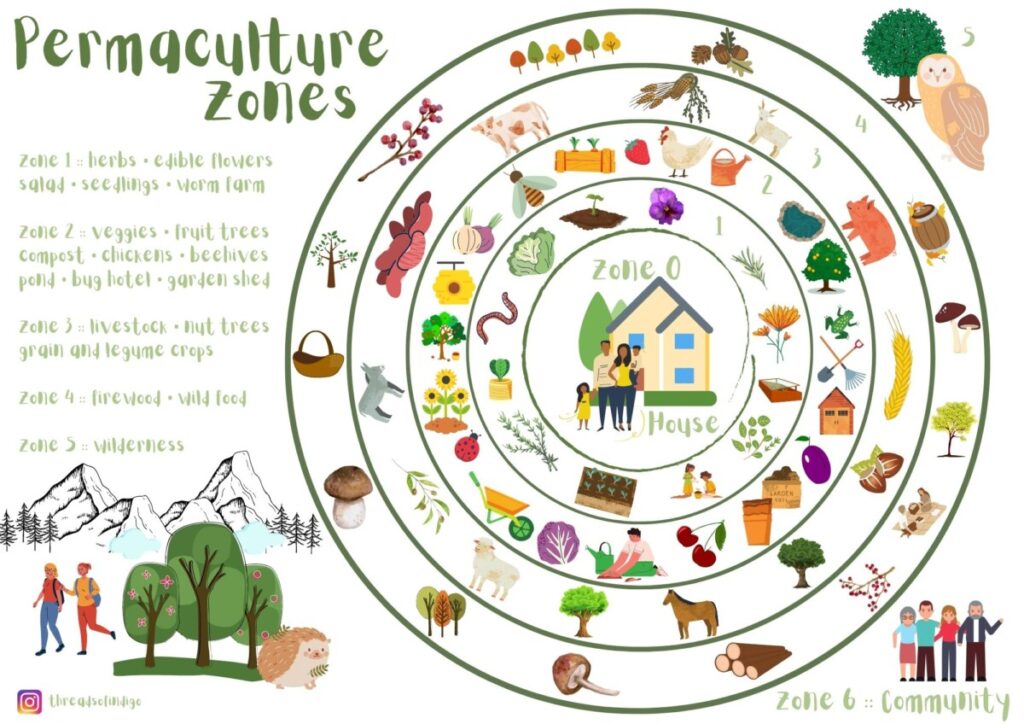
What is Permaculture?
Permaculture is an ethically driven design system that is based on observing the intelligence and elegance of nature. It asks the fundamental question of what does a society look like and how does it operate if it sought a regenerative relationship with nature in which the ecology thrived rather than collapsed over time. In many ways, it is the fundamental question that any aware human being should be asking.
When we ask that question, we need to look at systems that provide our everyday needs with greater care. These include but are not limited to: food, energy, shelter, livelihood, health care, community and mobility. What is permaculture evolves over time as we both learn from the indigenous wisdom of skilled land stewards and incorporate the increasing complexity of scientific discoveries.
Despite the breadth and complexity of what is permaculture, the practice of it should be beautiful and nourishing. Eating food from your garden, making medicine from the plants that grow in your biome, gathering with community over art and other things that matter, planting fruit trees and riding your bicycle, building soil and tending chickens and bees seem to be common paths that many permaculturists end up finding the most sense in creating a lower carbon footprint and a better possible ecology for their descendants to live in.

The three ethics of permaculture are Earth Care, People Care, and Fair Share. These ethics, outlined by Bill Mollison and David Holmgren, guide individuals and communities to create sustainable, regenerative, and ethical systems for living in harmony with nature and each other.
Earth Care involves working with natural systems and conserving resources.
People Care focuses on ensuring the well-being and self-reliance of communities.
Fair Share is about fairly distributing resources, setting limits on consumption, and returning surplus to the system.
Practical Applications of Permaculture
 Ecological & Land-Based Practices
Ecological & Land-Based Practices
Water harvesting (ponds, dams, keyline design, rainwater catchment)
Renewable energy systems (solar, wind, micro-hydro)
Aquaculture & aquaponics (integrating fish, plants, and water systems)
Polycultures & succession planting (designing for time as well as space)
Agroforestry & silvopasture (integrating trees with food production and animals)
Wildlife habitat creation (pollinator corridors, beneficial insect habitat)
Seed saving & propagation (building resilience through genetic diversity)
Soil regeneration techniques (composting, biochar, fungal inoculation, cover crops)
Built Environment & Infrastructure
Natural building (cob, strawbale, earthbag, timber framing, passive solar design)
Appropriate technology (rocket mass heaters, solar cookers, composting toilets)
Eco-villages & intentional communities (designing human habitats to be regenerative)
Social & Cultural Permaculture
Decision-making frameworks (consensus, sociocracy, Holacracy)
Economics of permaculture (local currencies, cooperative enterprises, fair share systems)
Education & skill-sharing (community workshops, teaching resilience skills)
Conflict resolution & community health (restorative justice, nonviolent communication)
Lifestyle & Systems Thinking
Personal permaculture (designing your daily life for resilience and balance)
Urban permaculture (balcony gardens, rooftop systems, guerrilla gardening)
Waste as resource (circular systems, cradle-to-cradle design)
Pattern literacy (understanding natural patterns like spirals, branching, waves, and applying them in design)
In short, permaculture is not just a land-use strategy but a whole-systems design approach—integrating food, water, shelter, energy, community, and culture.

Permaculture Principles: Work with nature, rather than against the natural elements, forces, pressures, processes, agencies, and evolutions, so that we assist rather than impede natural developments. The problem is the solution; everything works both ways. It is only how we see things that makes them advantageous or not (if the wind blows cold, let us use its strength and its coolness to advantage). A corollary of this principle is that everything is a positive resource; it is just up to us to work out how we may use it as such.
 Benefits of well-developed permaculture projects include:
Benefits of well-developed permaculture projects include:
- Conserving and building healthy soils, the basis of food systems.
- Diversifying and greatly increasing local food production, which increases the nutritional quality and benefits of local diets and buffers against market fluctuations in food prices.
- Eliminating use of toxic chemicals that cause a variety of health problems from immediate toxic poisonings to longer-term chronic problems like cancer, birth defects and the destruction of healthy natural food source.
- Maximizing efficient beneficial use of local water sources, the critical lifeblood for people.
- Practically eliminating pollution of water by human wastes, thereby dramatically reducing toxins.
- Creating clean drinking water sources, further reducing disease.
- Increasing tree crops, which retain soils, slow water runoff, increase groundwater storage, and provide shade.
- Increasing the beauty of the community though the creation of diverse life forms – flowers, insects, birds, frogs, and hundreds of others that create a pleasant and inspiring atmosphere for people.
- Harnessing natural renewable energies to create comfortable home living conditions.

🌱 In permaculture design, zones are a way of organizing space based on frequency of use, energy, and attention needed. Instead of designing randomly, you place elements in locations that make sense for how often you interact with them.
Zone 0 – Home / Self
Zone 1 – Kitchen Garden
Zone 2 – Perennials & Small Animals
Zone 3 – Farming & Larger Crops
Zone 4 – Semi-Wild Resources
Zone 5 – Wilderness / Conservation

Download this informative 12-page PDF; The Essence of Permaculture, by David Homgren
